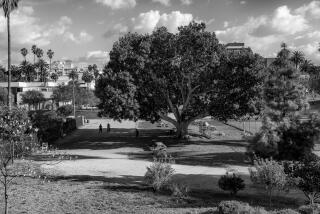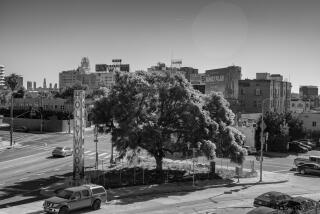3 Acres of History : Center Seeks to Preserve Rare Varieties of Apples
- Share via
BOLINAS, Calif. — Imagine sinking your teeth into a juicy apple that tantalizes your taste buds with a startling hint of cinnamon, bananas, licorice or sassafras.
Jesse Schwartz shudders to think that the average consumer instead routinely seeks fruity fulfillment with the over-bred and almost tasteless red and yellow Delicious apples or the MacIntosh.
“Americans have been deprived of their historic heritage and nothing is more American than the apple,” he said.
Dozens of varieties of apples were available at the turn of the century. But Schwartz said the desire for a uniform apple that would travel well from the orchard to the store shelves has put all but a few varieties of about 5,000 existing strains at the brink of extinction.
Saving them is the goal of the Living Tree Center, run by Schwartz and his friend, center general manager John Kozak.
‘Historic’ Apples
With an almost religious fervor, the Brooklyn native and ex-engineering professor has assumed the task of chief propagator of what he calls “historic” apples at the three-acre Living Tree Center nursery in Bolinas, about 30 miles north of San Francisco.
“One of the ills of the modern world is that we’ve been cut off from our roots, we’ve been cut off from the land and I think that it’s time that we think about returning,” Schwartz said.
“Red Delicious has been so hybridized, has been so over-bred that it’s become altogether tasteless,” Schwartz said. “Every nursery in the country is continuing searching for another bud mutation of red Delicious . . . a deeper red or an apple that’s more uniform or stays on the tree until ready for harvest.”
Schwartz and Kozak travel across the country, searching backyard orchards in hopes of finding one of the increasingly rare varieties of apples they believe is worthy of salvation.
Graft Stalk to Root
They tenderly graft stalks of their discoveries to various types of hardy root stock from Oregon, then bind the new creations with a special blend of plastic tape, beeswax and pine resin.
Their trees are carefully planted in the three-acre Paradise Valley nursery on the fringe of Bolinas. The trees are fed with an organic compost that includes seaweed and coffee grounds, then watered from a nearby river. No herbicides, pesticides or chemical fertilizers are used.
The clonal propagation “means when somebody buys from us a Spitzenburg, they are partaking of the self-same tree that Thomas Jefferson grew at Monticello,” Schwartz said. “We have Thomas Jefferson’s favorite apple and we propagate it by the hundreds. It’s one of our best-selling trees.
“We don’t plant seeds for apples because . . . the progeny will be very different from the forebears.”
66 Varieties
The Living Tree Center began in 1979 with 24 apple trees in Schwartz’s backyard. Today it boasts 66 varieties and is the only nursery in the nation to grow the Reinette Simirenko, a Ukrainian apple so popular that it was rocketed into outer space by Soviet cosmonauts.
It also offers the pink pearl, with pink flesh and greenish-yellow skin. Another favorite is the Cox’s orange pippin, the most popular apple in Europe and England.
Among the other apples are the Rockingham red, Skinner’s seedling, cinnamon spice and Coos River beauty. Each tree, sold as one-year or two-year slips and shipped while dormant, is priced at about $15.
The Living Tree Center periodically offers “gourmet apple tastings,” similar to wine tastings.
“These historic apples cannot be purchased in stores at the present time,” Schwartz says in his Living Tree Center catalogue and planting guide. “If you want a really good apple you’ve got to grow it yourself.”






